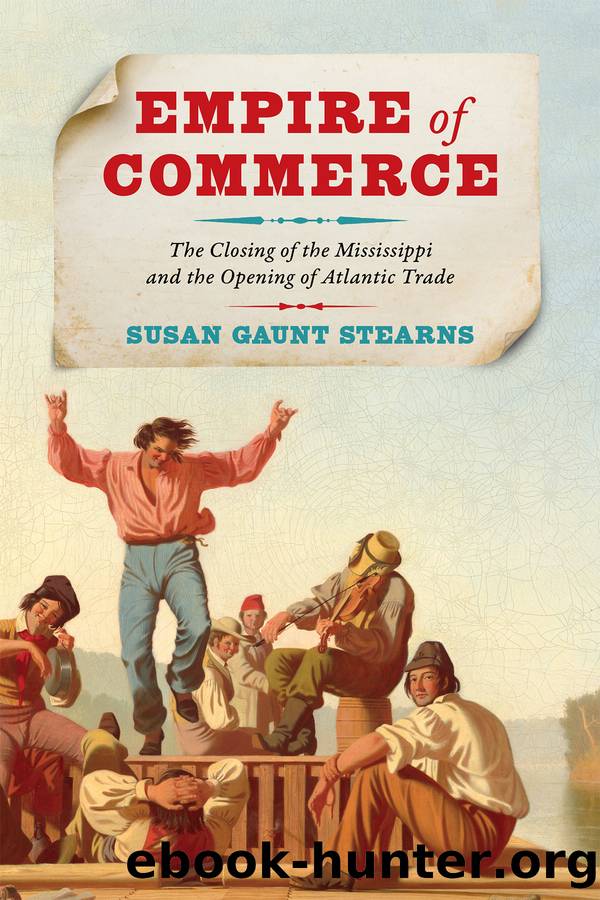Empire of Commerce by Susan Gaunt Stearns;

Author:Susan Gaunt Stearns; [Stearns, Susan Gaunt]
Language: eng
Format: epub
Tags: HIS036030 HISTORY / United States / Revolutionary Period (1775-1800), HIS036120 HISTORY / United States / State & Local / South (AL, AR, FL, GA, KY, LA, MS, NC, SC, TN, VA, WV), BUS023000 BUSINESS & ECONOMICS / Economic History
Publisher: Lightning Source Inc. (Tier 3)
8
American Trade in a Spanish Port
Once the river was opened, the agricultural produce of trans-Appalachia poured down the Mississippi. Along the Monongahela, Kanawha, Kentucky, Muskingum, Miami, Tennessee, and Cumberland Rivers, western farmers and merchants embarked with flour, salted meat, whiskey, cordage, and hemp for sale in New Orleans. French merchant François Michaux, who traveled through the West first in 1796 and again in 1802, reported that of the â85,570 barrels of flourâ that floated past the new city of Louisville in the first six months of 1802, âmore than two thirds of this quantity may be considered as coming from the state of Kentucky, and the rest from Ohio and the settlements situated on the rivers Monongahela and Alleghany [in Pennsylvania].â1 Further downriver, produce from Nashville and the new state of Tennessee (admitted in 1796) joined the flow.
Above all other crops was cotton. In the mid- and late 1790s, farmers from the Gulf of Mexico north to the Ohio experimented with growing the staple. In 1796, Tennessee surveyor Daniel Smith speculated that cotton âmust be a constant source of wealth to the planter. . . . It must be in constant demand in foreign markets.â2 Smithâs prediction rapidly came true, as farmers and merchants in the Cumberland region around Nashville turned to cotton as a key commercial crop. In 1800, the Nashville partnership Hennen and Dixon accepted âHemp, Pork, Flour, in barrels, cotton, bees-wax, and from 20 to 30 good Beef-Cattleâ to settle its debts; by 1802, the merchants planned to accept only âCash, or Cotton.â By 1803, in a telling inversion of the traditional preference for cash, merchant Joseph Martin requested that âall those who cannot pay him their accounts in cotton . . . come forward and pay in cash.â He planned to âpurchase cotton therewith.â These advertisements marked profound changes to the region from only a few years prior, when Michaux had speculated that ânot one in ten of [the western inhabitants] are in possession of a single dollar.â3
The opening of Mississippi River trade hinged on the right of deposit guaranteed by Pinckneyâs Treaty. Permission to âdepositâ goods gave Americans the ability to transship merchandise imported into the colonyâwhether flour, tobacco, and cotton arriving from upriver, or fabric, house paint, and nails arriving from the East Coastâwithout paying Spanish import or export taxes. The right of deposit allowed the heavily laden flatboats that originated in Kentucky, Tennessee, or Natchez to unload their cargo in New Orleans, where the goods could be stored until their importer found a buyer who would then load them onto ships bound for ports throughout the Atlantic world. The right of deposit also allowed American merchants to bring in American finished goods destined for western settlements; on arriving in New Orleans, those goods would be transferred onto smaller, lighter boats capable of navigating against the currents and eddies of the Mississippi.
Beginning with the opening of the right of deposit in April 1798, every arriving American merchant or farmer was required to unload their
Download
This site does not store any files on its server. We only index and link to content provided by other sites. Please contact the content providers to delete copyright contents if any and email us, we'll remove relevant links or contents immediately.
International Integration of the Brazilian Economy by Elias C. Grivoyannis(75476)
The Radium Girls by Kate Moore(11626)
Turbulence by E. J. Noyes(7708)
Nudge - Improving Decisions about Health, Wealth, and Happiness by Thaler Sunstein(7253)
The Black Swan by Nassim Nicholas Taleb(6773)
Rich Dad Poor Dad by Robert T. Kiyosaki(6185)
Pioneering Portfolio Management by David F. Swensen(6083)
Man-made Catastrophes and Risk Information Concealment by Dmitry Chernov & Didier Sornette(5658)
Zero to One by Peter Thiel(5498)
Secrecy World by Jake Bernstein(4393)
Millionaire: The Philanderer, Gambler, and Duelist Who Invented Modern Finance by Janet Gleeson(4106)
The Age of Surveillance Capitalism by Shoshana Zuboff(3991)
Skin in the Game by Nassim Nicholas Taleb(3973)
The Money Culture by Michael Lewis(3851)
Bullshit Jobs by David Graeber(3837)
Skin in the Game: Hidden Asymmetries in Daily Life by Nassim Nicholas Taleb(3731)
The Dhandho Investor by Mohnish Pabrai(3564)
The Wisdom of Finance by Mihir Desai(3529)
Blockchain Basics by Daniel Drescher(3332)
